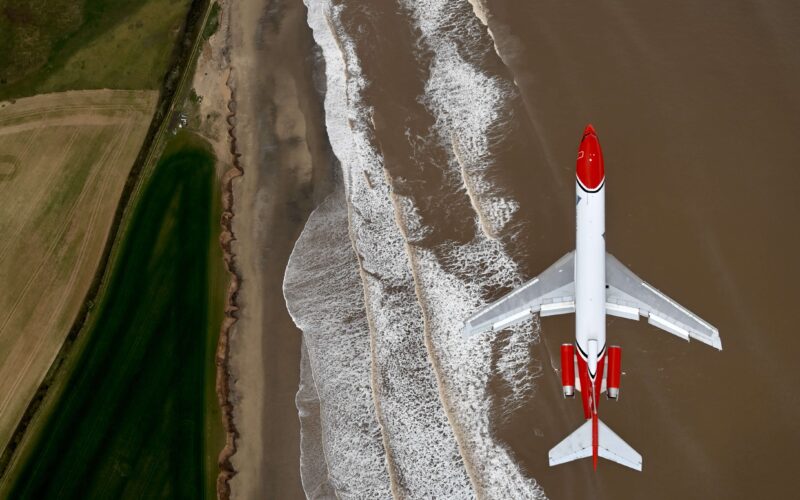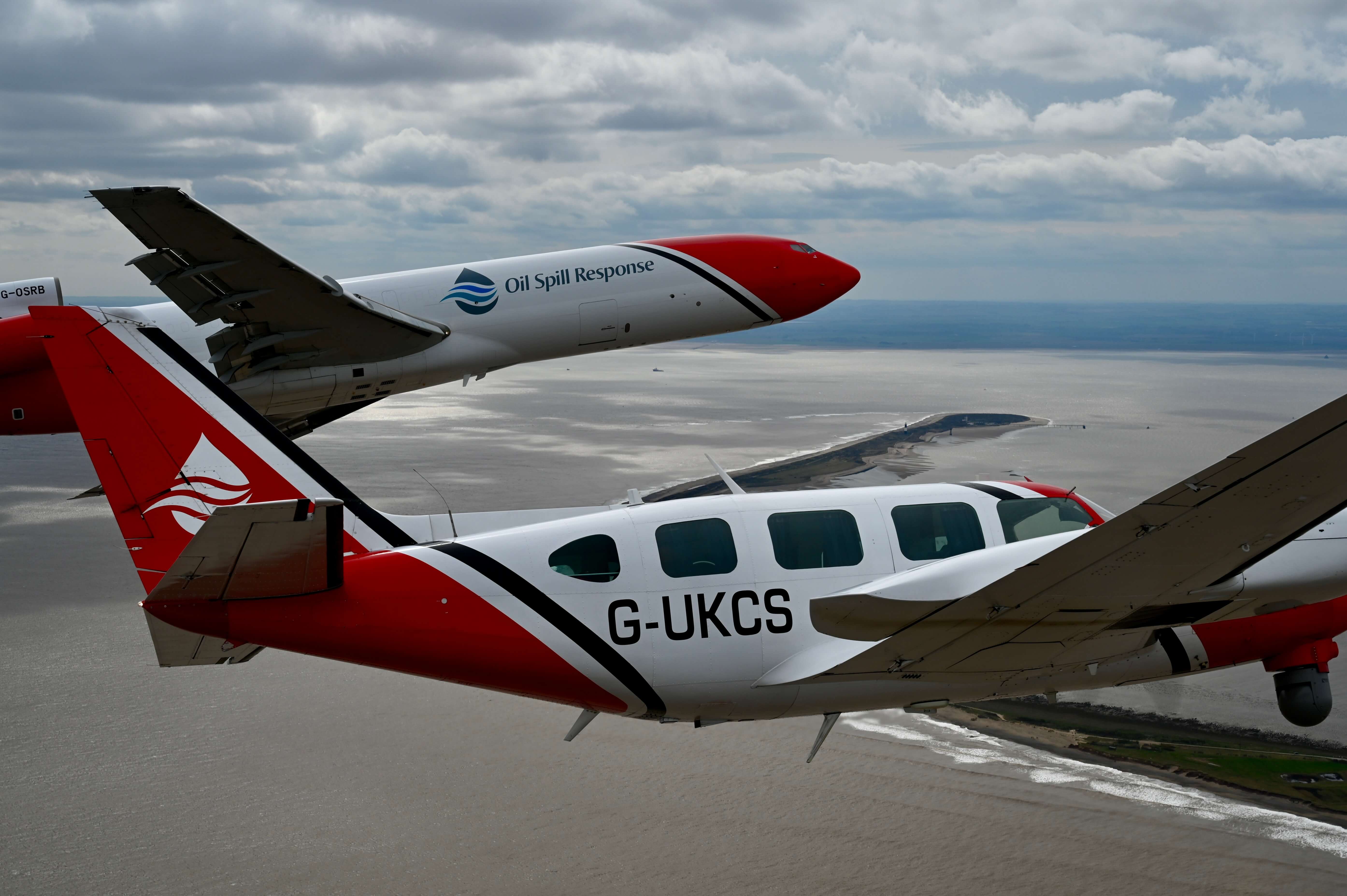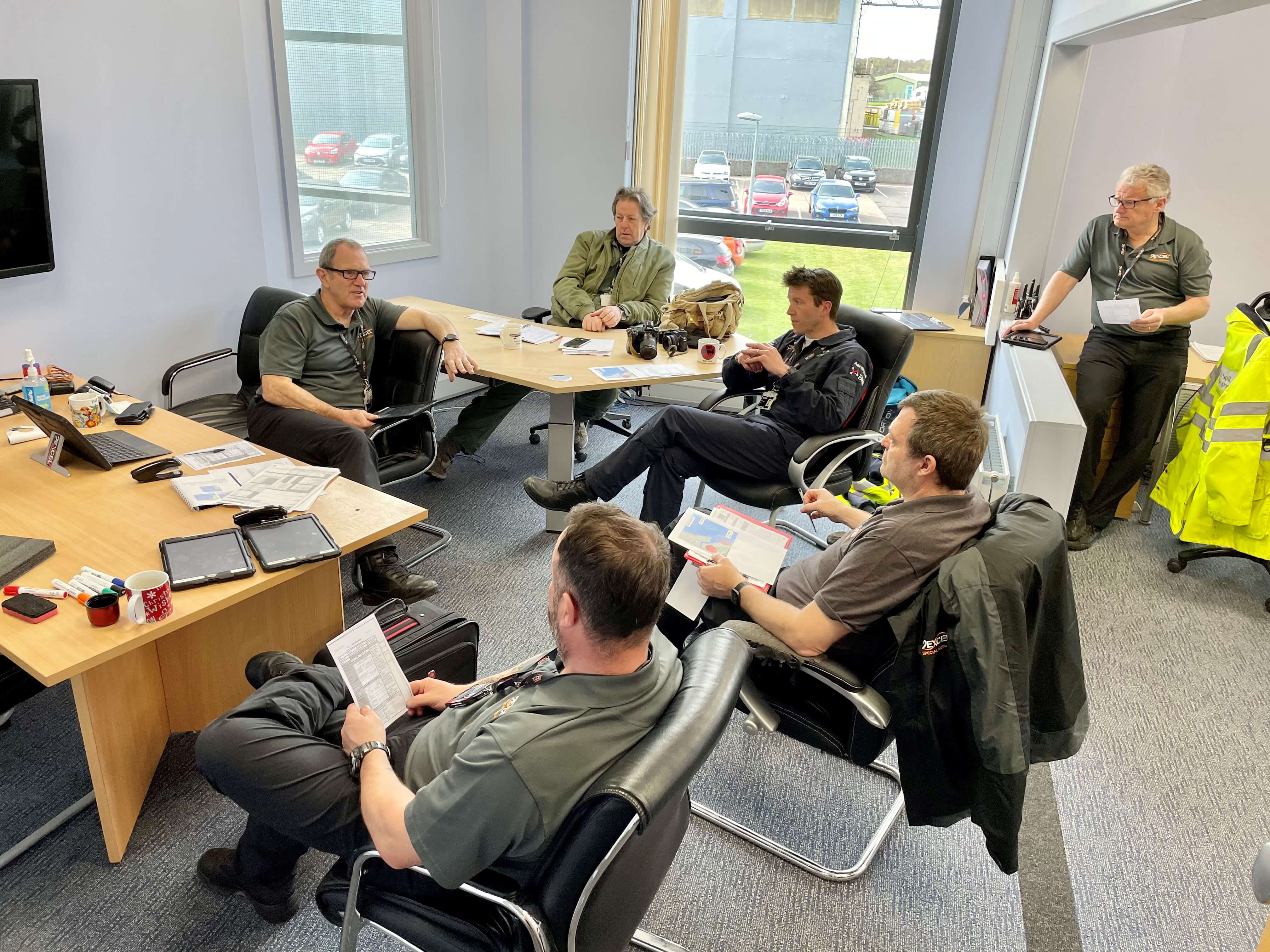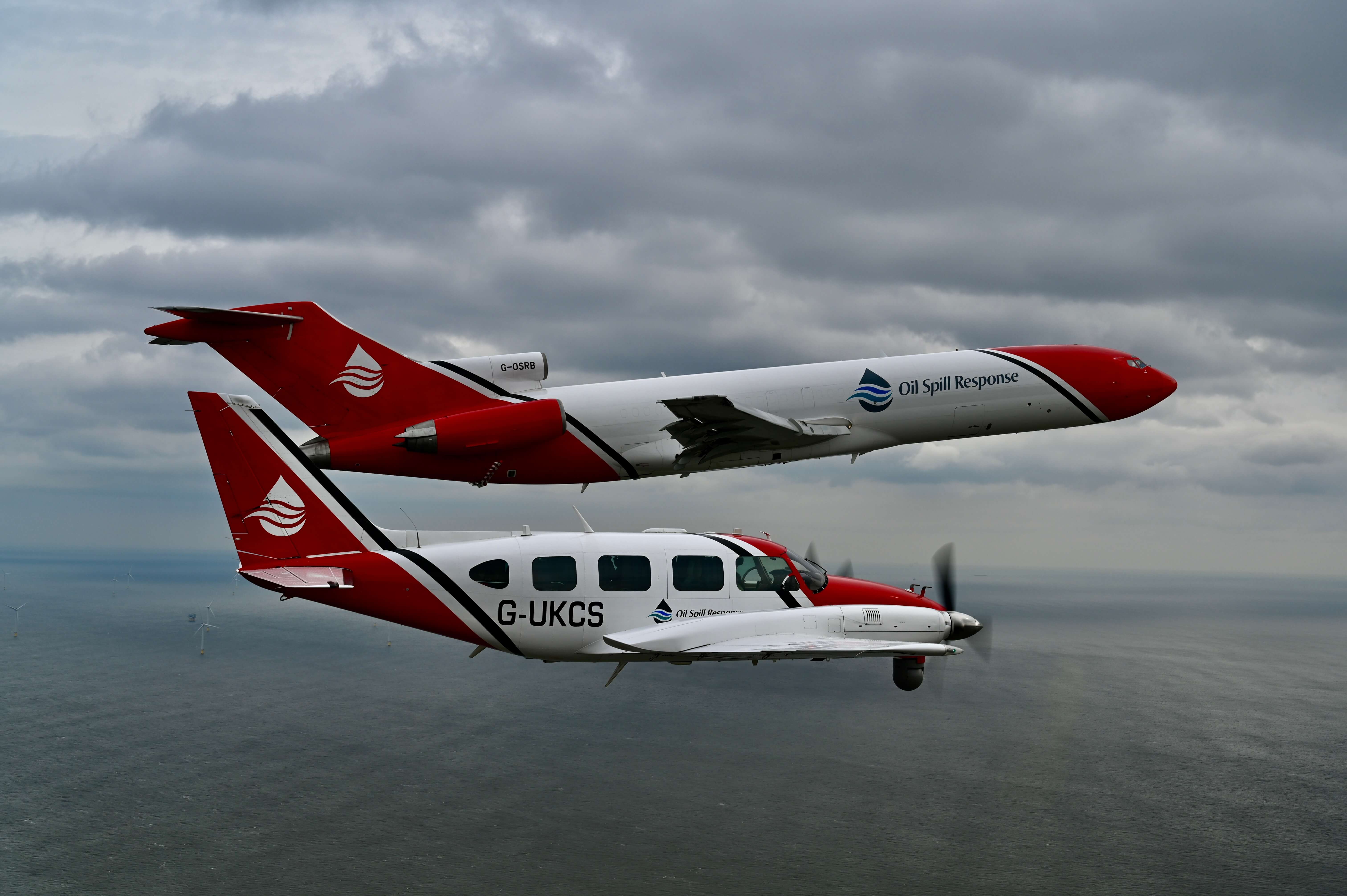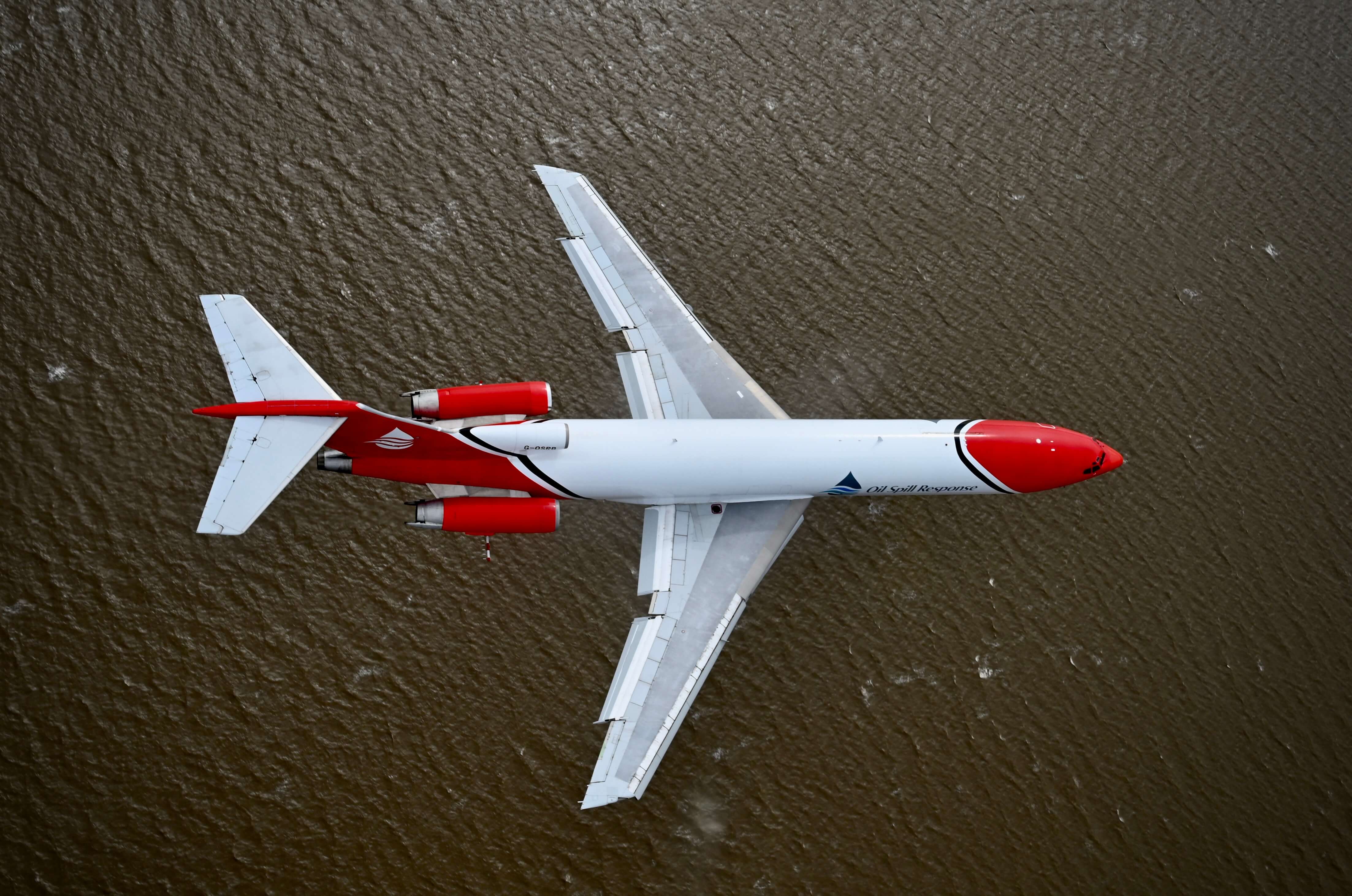Air-to-air photography requires exceptional skill and a high level of experience from a multitude of professionals. Renowned for being the most challenging to capture, aerial photoshoots are also inspiring – not only visually – but through the demonstrable interface of human and machine.
It takes three aircraft, nine crew, and a supportive ground operations team to get awe-inspiring shots like this:
Image by Ian Black
AeroTime CEO Richard Stephenson caught up with Pat Cafferky, the Special Missions B727 Captain and Head of the Counter Pollution team at 2Excel Aviation, to speak about flying, the counter pollution work Cafferky and 2Excel do, and the recent photo shoot the company made to illustrate the important contract supporting Oil Spill Response.
Preparing for an air-to-air photo shoot
A Boeing 727, a Piper Navajo, and an Extra 300 – a formation sortie like no other. Flown by former RAF fast-jet pilots – two being ex-Red Arrows, one Tornado display pilot, and a former 8-ship lead from the Jaguar days. It is critical for the crew to understand the complexity of formation flying and crucial to deploy proper Threat and Error Management to make the sortie as safe as possible.
After six months of personnel and aircraft serviceability planning, which first and foremost included a risk assessment, deconfliction planning, and approval from 2Excel’s Director of Flight Operations and the Accountable Manager, a good weather window opened up an opportunity to finally get this air-to-air sortie off the ground.
Everything had to fall into place to enable the successful delivery of this project – from crewing to air traffic control.
As the day finally arrived, it started with a full team briefing that morning, led by 2Excel’s Special Missions B727 Captain Pat Cafferky.
Team briefing, led by Special Missions B727 Captain Pat Cafferky (in the centre of this image with his arm on the chair back). Image: 2Excel
During the briefing, the crew discussed safety issues, any constraints which they and or the aircraft may come across, roles and responsibilities for the sortie, domestics requirements, a final weather check, photo requirements, and aircraft endurance. This ensured that the team was aligned in its safety parameters but also had a final opportunity to discuss and eliminate any and all question marks. There’s no room for egos among such experienced aviators, which allows for open discussion as a group and total confidence in each other.
With the support from 2Excel’s long-term customer, Oil Spill Response (OSRL), the team boarded its Boeing 727 (G-OSRB) and support aircraft, a Piper Navajo (G-UKCS) – both sporting the striking red and white livery of OSRL – and took off for the skies off the coast near 2Excel’s operations base at Doncaster-Sheffield Airport, in South Yorkshire, England.
Pat, together with co-pilot Mike Baverstock and UKCS Flight Commander, Gary Lovett, led the formation, which saw an Extra 300 aircraft, piloted by Blades Aerobatic Display pilot, Ben Murphy, and Ian Black – a highly experienced aerial photographer and current Virgin Atlantic airline pilot – fly alongside the 200,000lb B727. The former Fed-Ex cargo jet now stands ready 24/7 to respond for OSRL’s customers in the global oil industry. Once airborne, operating off the coast of Hornsea, the team would make visual contact and manoeuvre their aircraft into formation.
Pilots’ perspective of the aerial photography sortie
Pat Cafferky shares his account on leading the sortie:
“We were met with scattered cloud around 1,200ft but otherwise good visibility. The key to providing a stable lead aircraft is predictability. Stick to the brief, have a contingency plan but above all else be predictable. Mike was at the controls for the majority of the sortie, hand flying the 727 to keep a tight grip on bank angle and roll rates. That allowed me as Captain to maintain an overview of the operation, keeping the formation clear of hazards, built-up areas and other aircraft.”
“Alastair, our Flight Engineer, not only monitored the aircraft systems, fuel, pressurisation, etc, he was a critically important extra pair of eyes clearing turns and listening out on our discrete ATC frequency. Communicating the start and end of each manoeuvre is key. Mike’s previous experience as the RAF’s Tornado display pilot gave him a high degree of empathy with the other crews, again a critical skill when flying in close formation. Whilst the B727 was operating towards the lower end of its performance envelope, the PA-31 and Extra were both at their higher end.”
Image by Ian Black
“We decided to use 150 kts as the baseline formation speed with Flap 15 deployed to keep the angle of attack manageable. A maximum bank angle of 20 degrees ensured Andy was never outpowered on the outside of any turn. The B727 is very speed stable but without the luxury of auto-thrust on the tri-jet we realised early on that the best approach would be complete manual flight. Ben and Andy were working hard to keep station with Ben in particular manoeuvring the Extra to offer Ian the best shot. Hearing both UKCS’s engines and the Extra’s buzz saw alongside was great. One moment sticks in my mind when Ben rolled the Extra inverted over the top of the 727 to give Ian the perfect vertical shot. The upper cockpit quarterlight gave me a great view of the photo-chase aircraft above us. Simply brilliant to watch! Although I’d already experienced civilian formation flying with the Blades at Farnborough in 2018, it’s still a thrill to be that close to another aircraft in the same piece of airspace.”
Andy Evans was at the controls of G-UKCS:
“UKCS was flying at around 2500ft until it reached the coastline where we then made visual with OSRB. The size comparison is remarkable – it really is like David and Goliath when you’re up there. My crew were excellent – making sure we had wingtip clearance at all times while manoeuvring around the skies. Prior to the flight, Pat and I ‘wing walked’ the positions on the ground to seek out the visual references that we knew would keep the PA-31 clear of wake turbulence or vortices.”
Once the two aircraft were flying straight and level, it was the responsibility of the Extra 300 to capture the dynamic photographs. With the ability to withstand high G forces, the Extra 300, and its crew, are perfectly matched to carry out this type of task.
Extra 300 pilot, Ben Murphy flew Ian Black inverted to capture incredible bird’s-eye shots:
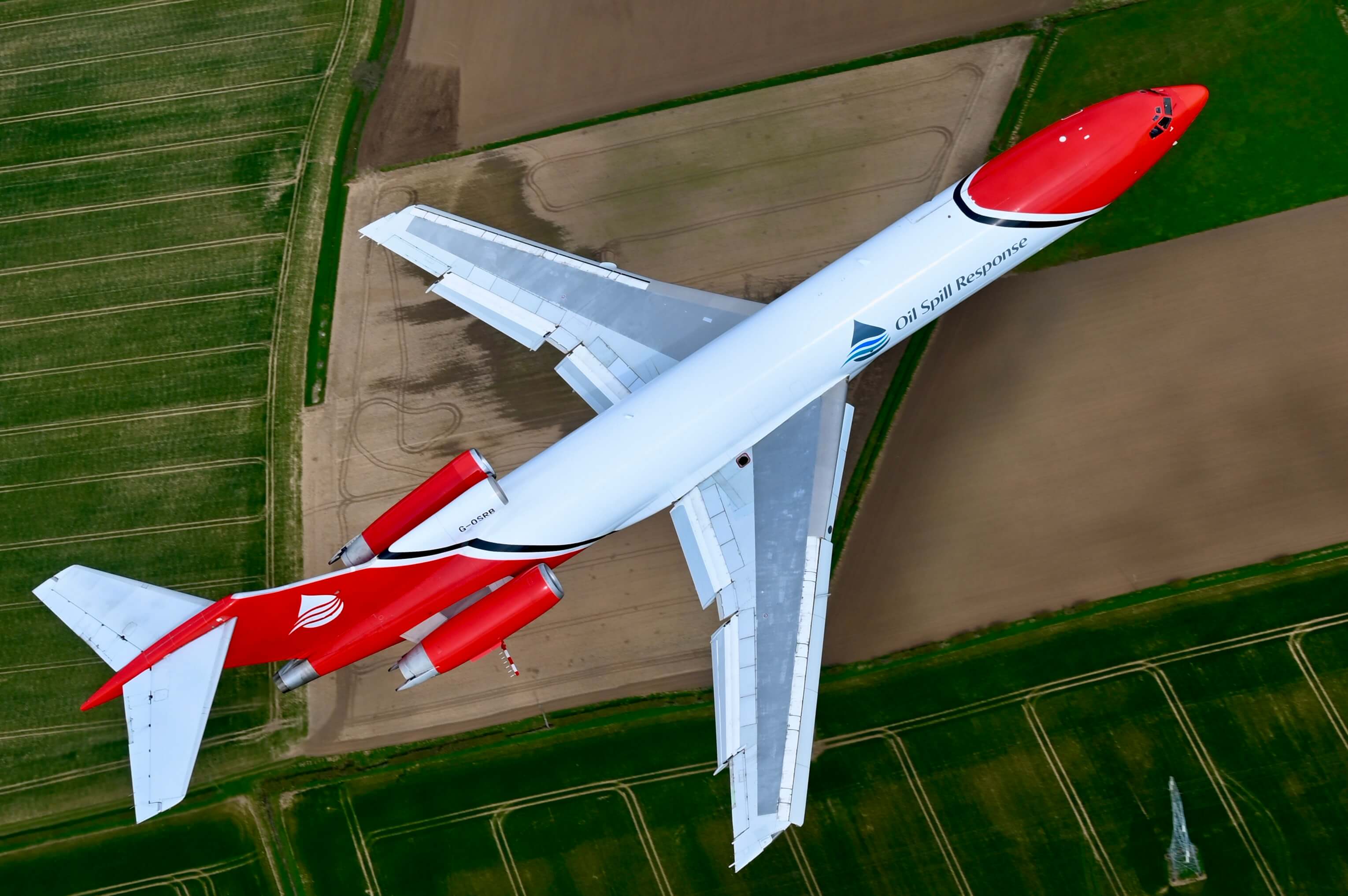
“Dissimilar formation (different aircraft types) always brings its challenges, but the beauty of 2Excel Aviation is that we have an abundance of experience and skillsets in making these difficult sorties work! We know from our collective military and display flying experience, that the plan is the simple bit; it is the unexpected, the emergencies, and the ‘what-ifs’ that will catch you out if you have not considered them beforehand and have a plan for them. All the while, we are conscious of the actions to be taken if any eventuality arises – for example, if one aircraft has an emergency and needs to quickly break out of formation, or another aircraft loses its radio, etc.”
“My job for the day was to accurately position the Extra in a variety of places to give Ian the best chance of a great photo. These again have been planned on the ground but there is constant communication between photographer and pilot to ensure we are in the right position to capture the ‘perfect shot’. Rolling inverted over the top of a B727 is not something you do every day and flying dynamic manoeuvres that close to a large aircraft requires concentration and awareness of the rapidly changing vectors to remain safe. To get the energy to pull off that manoeuvre requires diving down ahead of the formation (to build up speed) before pulling up and rolling around, then holding the aircraft upside down to allow Ian to get the shot. Whilst the flying is demanding, I must tip my hat to Ian for not only coping with the rollercoaster ride, but also managing to get these fantastic shots!”
The aerial shoot lasted one hour and, in that time, the team successfully captured a wide range of photos over sea and land, some with a stunning view of the iconic Humber Bridge and beautiful coastline.
The story from behind the photographer’s lens
Photographer, Ian Black, reminisces about the 727 and shares his experience of flying with this iconic aircraft.
“Riding with the King… I have a confession to make… Not many aeroplanes make me go weak at the knees and even fewer civilian types make me buckle, apart from one. The Boeing 727 has captured my imagination for as long as I can remember. The iconic 70s-swept wing jet airliner oozes sex appeal and class in its design.”
“Never having had a nickname apart from the ‘tri jet’, the 727 caught my eye as I started my life as an airline pilot – hot humid days in Miami watching the 727s accelerate into the sky is my Kodachrome memory. Luckily 2Excel’s variants have the JT8-217 “hush kits” keeping them noise compliant and markedly “cleaner” when compared with the first generation of the jet.”
“The story of DB Cooper is the stuff of aeronautical legends – the rear stairs dropping down in flight allowing the elusive DB to parachute into obscurity in the inky black sky weighed down with dollar bills and jewellery after his famous hijack. The stories of CIA 727s operating in Vietnam on clandestine missions only adds to the 727s street cred.”
“When I obtained my South African licence at Wonderbloom Airport in Pretoria, a lone 727 sat forlorn on the apron its murky past and secret missions the stuff of dreams. I later met some mercenaries who told me its story but that’s for another day. And so, a decade or two on and now a captain of Boeing’s latest incarnation, the 787 Dreamliner, I finally get to ride with the King.”
“A request from Ben Griffiths, 2Excel’s Group Head of Communications, to capture some images of the Oil Spill Response aircraft based out of Doncaster-Sheffield Airfield grabs my attention like a fly in a UV light after six months of lockdown!”
Image by Ian Black
“The mission brief was to capture new marketing images of the 727 and PA31 Navajo – that’s the easy part. The hard part is melding a plan together that captures the role of the aircraft as well as the expertise of the crews. My initial thoughts were the dynamic range of the aircraft involved – the 727 is a big aircraft, three engines fast and nimble for a narrow body jet but producing a big wake.”
“The PA31 is an old twin, heavy on the controls and not the most pilot friendly aircraft for doing close formation – the slowest the 727 can safely fly is around 140 knots with the flaps at 10-20 degrees so this gives the PA31 a bit performance but the crucial part of the jigsaw is what camera ship?”
“My initial thoughts were using a Jet Provost – 140-150Kts is reasonably comfortable but its range is actually pretty limited, so I looked at a compromise. I didn’t have to look far as I knew that not only did the Blades Aerobatic team have a highly manoeuvrable aircraft in the Extra 300, they also had the most competent aerobatic pilots in the UK, if not the world.”
“Trying to pull all the parts of the jigsaw together is a massive team effort with everyone playing their part just to “make it happen”, even the lady who brings the sandwiches! Whilst the planning of the shoot took up a lot of time the one factor that was always going to be in the lap of the Gods was the weather and it was attempt three when we finally all met up at Robin Hood Airport home of the 2Excel Oil Spill operation.”
“With a favourable weather forecast the decision was made to launch the three aircraft just after midday. The original plan had us flying out over the North Sea but as we had a single engine aircraft this was modified so we were always in sight of land and with a fair wind we might just glide to the beach if we encountered any issues.”
“Having spent my early RAF career in and around the River Humber and Spurn Point I knew the area well and started to formulate some images in my head – I had one “money” shot that I knew would be hard to achieve but felt it was worth trying.”
“As we departed Doncaster’s Southerly runway it’s only then that you know it’s going to happen – seeing the distinctive red and white 727 in a rear view was a welcome sight – six months of planning was finally coming together.”
“My ‘chauffeur’ for the day was Ben Murphy and if you need to be put into a piece of sky at a certain angle, a former Red Arrows leader, Red Bull Air Race pilot and VSTOL Harrier Pilot is as good as it gets. Sticking close to the 727 we cruised up the Humber looking for backdrops whilst barrel-rolling around the sky – the pre-flight pork pie I devoured was now seeming like the worst decision of the day!”
“I’d asked the 727 pilot to head to the coast and then turn North – I’d studied Google maps and I calculated there was one small stretch of coast that might give the unique image – green fields, yellow sandy beach, a dash of Elephant brown North Sea and the brightly painted Oil Spill Response 727 – the contrasting colours would be hard to beat … to add to the complexity, I needed to be in the pure vertical inverted as the 727 held the exact distance off the coast.”
“The stars were aligned and in one Nano-second, I could see my vision captured for eternity. With the money shot in the bag we headed out to sea, where by chance a super-tanker was gently cruising its way to the coast – nice backdrop. An hour on task and around 40 barrel rolls, it was time to RTB – six months of planning, probably 100 people involved in some way or another and it was over.”
“Riding with the King was up there with the rest when it comes to memorable days.”

